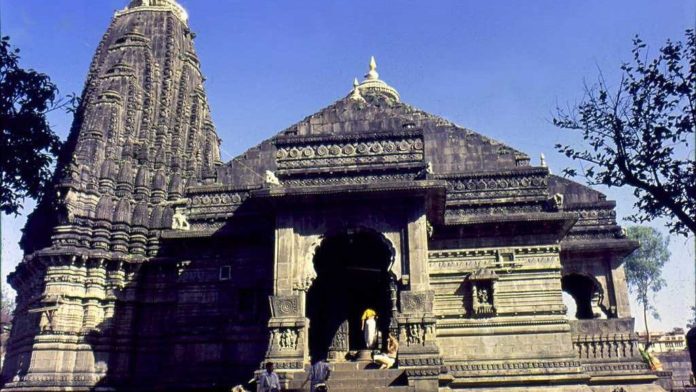The Trimbakeshwar Temple is located in the town of Trimbak, in the district of Nashik in Maharashtra, India. The temple sits encompassed by three hills, namely – the Brahmagiri, the Nilagiri and the Kalagiri. The river Godavari emerges from a pond named ‘Kusavarta’ here, and flows into the Bay of Bengal after traversing the lengths of peninsular India through its main stream and tributaries.
… वाराणस्यां तु विश्वेशं त्र्यम्बकं गौतमीतटे। …
This is an extract from a Sanskrit shloka which speaks of the twelve Jyotirlingas – the devotional representations of the Hindu God – Lord Shiva. The Trimbakeshwar Temple is considered to be one of the twelve Jyotirlingas. Followers of Hinduism believe that if a person visits all twelve of these jyotirlingas, he achieves eternal salvation from the grim realities of this cosmic world. Many devotees visit the Trimbakeshwar Temple seeking redemption from all worldly sins and evil. The famous Kumbh Mela is organized here once in every twelve years.
The temple has three lingas, many shrines dedicated to Lord Shiva, Goddess Parvati and Lord Ganesha and several images of Gangadevi, Rama, Krishna etc. The temple also houses monasteries and samadhis which house the remains of saints in its complex.
The Legends
There are many legends associated with the temple, each one following a different narrative. The most popular ones are mentioned below.
A long time ago, a sage named Gautam Muni was believed to reside Brahmagiri hill with his wife Ahilya. The Rishi was endlessly devoted to Lord Shiva. To honor his devotion, he was gifted a bottomless pit that could produce an endless supply of food and grains by Varuna. All the other sages were jealous of this prized possession, so, they arranged for a cow to enter into the pit and die in it to render the prize impure and thus, futile. Under such circumstances, the Rishi prayed to Lord Shiva asking him to bring the river Ganga down to purify the premises. Lord Shiva requested Goddess Ganga to flow down to the area and also asked her to stay there for eternity in the form of the river Godavari.
Another legend goes, once upon a time Lord Brahma and Lord Vishnu had searched for the origins of Lord Shiva and found him manifested in the form of a celestial column of fire. Lord Brahma lied about having seen the top of the fire and was then cursed by Lord Shiva that he was never to be worshipped on earth. Consequently, Lord Brahma cursed Lord Shiva that he shall be pushed underground. Therefore, Lord Shiva descended the Brahmagiri hill in the form of ‘Tryambakeshwar’. The Trimbakeshwar temple is the only temple where the Shivalinga is placed inside the ground.
Some experts believe that along with Lord Shiva and Goddess Ganga, Goddess Parvati also came down, thus, justifying the name – Trimbakeshwar. Others believe that the place is named after the Trinity considering the presence of the three lingas. It is, therefore, believed to be a temple that signifies the unity of the trinity of Hindu mythology.
The History
The Trimbakeshwar Temple is one of the oldest temples in India built in the pre-Vedic era. The temple was also subjected to destruction by Aurangzeb during his rule over India. Peshwa Nanasaheb had placed a bet on the stone inside the temple being hollow inside. He lost the bet and built the existing temple between 1755 to 1786 AD.
The crown placed on the main Shivalingam is believed to be installed by the Pandavas and later renovated by the Marathas. It is studded with jewels like diamonds, emeralds and many other types of precious stones. The temple once housed expensive jewels and valuables which were, unfortunately, looted by the Mughals and the British. The Eye of the Idol – Nassak diamond installed on the main Shivalinga was also stolen by the British during the Third Anglo-Maratha war. The diamond now resides in a private museum at Lebanon. There have been talks for the return and restoration of the diamond in the temple.
The Architecture
The temple is built out of pure basalt stone or black stone which has volcanic origins and is abundant in the region. The temple exhibits both Indo-Aryan and Nagara styles of architecture enclosing a spacious courtyard. The sanctum of the temple is square internally and flaunts a stellar structure externally while housing a small lingam – Tryambaka. The sanctum is crowned with a tall tower which narrows at the top, similar to a shikhara with many smaller imitations of its own. The main tower is also adorned with a giant Amalaka and a golden Kalasha at the top. Between the sanctum and the foyer stands a mandapa which has doorways on all four sides. Three of the doorways have been covered with porches whose openings are ornamented with pillars and arches. The entire structure of the temple is adorned with sculptured images featuring scrolls, gods, goddesses, humans, animals etc. It is one of the few temples in Peninsular India which displays North-Western style of architecture.
The tank of the temple is called Amritavarshini. The water from this tank is only used for snana – bathing the deity and abhisheka – a religious rite in which the devotee pours a liquid offering on the image of a god or goddess. The three other bodies of water are namely, the Bilva Teertha, the Viswanatha Teertha and the Mukunda Teertha. The tip of the Brahmagiri hill, where the river Godavari emerged from, is called ‘Ganga Dwara.’ It is located to the west of Trimbak. The Kushavarta Tirtha is a large reservoir located amid the village which accumulates water from the river Godavari. It is believed that a dip in the reservoir can wash away all sins. Several other places called Indra Tirtha, Prayag Tirtha etc. can also be found in the area. Each place has its own cultural significance according to the Hindu mythology.
The Trimbakeshwar Temple is, therefore, considered of immense significance within the Hindu religion. Many devotees visit the temple to worship Lord Shiva and seek his blessings.
By Srishti Singh
















